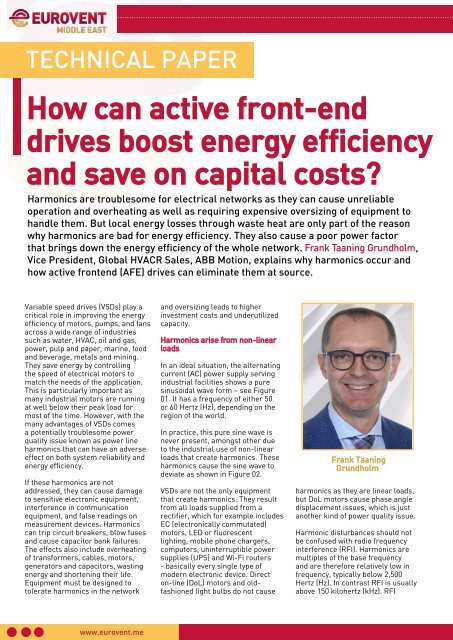EME Newsletter MEssage #1/2022
HVACR Industry news from Eurovent Middle East
HVACR Industry news from Eurovent Middle East
You also want an ePaper? Increase the reach of your titles
YUMPU automatically turns print PDFs into web optimized ePapers that Google loves.
NEWSLETTER<br />
TECHNICAL PAPER<br />
How can active front-end<br />
drives boost energy efficiency<br />
and save on capital costs?<br />
Harmonics are troublesome for electrical networks as they can cause unreliable<br />
operation and overheating as well as requiring expensive oversizing of equipment to<br />
handle them. But local energy losses through waste heat are only part of the reason<br />
why harmonics are bad for energy efficiency. They also cause a poor power factor<br />
that brings down the energy efficiency of the whole network. Frank Taaning Grundholm,<br />
Vice President, Global HVACR Sales, ABB Motion, explains why harmonics occur and<br />
how active frontend (AFE) drives can eliminate them at source.<br />
Variable speed drives (VSDs) play a<br />
critical role in improving the energy<br />
efficiency of motors, pumps, and fans<br />
across a wide range of industries<br />
such as water, HVAC, oil and gas,<br />
power, pulp and paper, marine, food<br />
and beverage, metals and mining.<br />
They save energy by controlling<br />
the speed of electrical motors to<br />
match the needs of the application.<br />
This is particularly important as<br />
many industrial motors are running<br />
at well below their peak load for<br />
most of the time. However, with the<br />
many advantages of VSDs comes<br />
a potentially troublesome power<br />
quality issue known as power line<br />
harmonics that can have an adverse<br />
effect on both system reliability and<br />
energy efficiency.<br />
If these harmonics are not<br />
addressed, they can cause damage<br />
to sensitive electronic equipment,<br />
interference in communication<br />
equipment, and false readings on<br />
measurement devices. Harmonics<br />
can trip circuit breakers, blow fuses<br />
and cause capacitor bank failures.<br />
The effects also include overheating<br />
of transformers, cables, motors,<br />
generators and capacitors, wasting<br />
energy and shortening their life.<br />
Equipment must be designed to<br />
tolerate harmonics in the network<br />
and oversizing leads to higher<br />
investment costs and underutilized<br />
capacity.<br />
Harmonics arise from non-linear<br />
loads<br />
In an ideal situation, the alternating<br />
current (AC) power supply serving<br />
industrial facilities shows a pure<br />
sinusoidal wave form – see Figure<br />
01. It has a frequency of either 50<br />
or 60 Hertz (Hz), depending on the<br />
region of the world.<br />
In practice, this pure sine wave is<br />
never present, amongst other due<br />
to the industrial use of non-linear<br />
loads that create harmonics. These<br />
harmonics cause the sine wave to<br />
deviate as shown in Figure 02.<br />
VSDs are not the only equipment<br />
that create harmonics. They result<br />
from all loads supplied from a<br />
rectifier, which for example includes<br />
EC (electronically commutated)<br />
motors, LED or fluorescent<br />
lighting, mobile phone chargers,<br />
computers, uninterruptible power<br />
supplies (UPS) and Wi-Fi routers<br />
- basically every single type of<br />
modern electronic device. Direct<br />
on-line (DoL) motors and oldfashioned<br />
light bulbs do not cause<br />
Frank Taaning<br />
Grundholm<br />
harmonics as they are linear loads,<br />
but DoL motors cause phase angle<br />
displacement issues, which is just<br />
another kind of power quality issue.<br />
Harmonic disturbances should not<br />
be confused with radio frequency<br />
interference (RFI). Harmonics are<br />
multiples of the base frequency<br />
and are therefore relatively low in<br />
frequency, typically below 2,500<br />
Hertz (Hz). In contrast RFI is usually<br />
above 150 kilohertz (kHz). RFI<br />
disturbances can be radiated and/<br />
or conducted. Harmonics are<br />
always conducted.<br />
The impact of harmonics on<br />
the network is measured as a<br />
percentage value known as the<br />
total harmonic distortion (THD).<br />
This is the ratio of the RMS<br />
(root mean square) harmonic<br />
content to the RMS value of the<br />
fundamental frequency. Where<br />
no voltage or current harmonics<br />
exist the THD is 0%. As the level<br />
of harmonics increases, the THD<br />
value increases. THDi is the total<br />
harmonic distortion on current<br />
and THDu or THDv is the total<br />
harmonic distortion on voltage.<br />
The higher the harmonic current<br />
content (THDi), the higher the<br />
losses in the power network – for<br />
example, a 40% THDi results in<br />
16% higher losses than a network<br />
with no harmonics. That means<br />
increased energy costs. And it also<br />
requires the electrical system to<br />
be dimensioned to carry the excess<br />
current.<br />
A single 4 kW drive, even with<br />
100% THDi, will not necessarily<br />
cause problems for the whole<br />
network. But it is important to<br />
consider the cumulative effect<br />
of harmonic distortion of a<br />
number of drives at the point of<br />
common coupling (PCC) – where<br />
the network serving the facility<br />
connects to the local utility<br />
distribution network.<br />
Methods for tackling harmonics<br />
Oversizing of critical electrical<br />
equipment is one approach to<br />
tackling the overheating created<br />
by the harmonic current. As<br />
an example, transformers and<br />
cables may be increased in size.<br />
Oversizing of backup generators<br />
is also a common way to mitigate<br />
some of the challenges created by<br />
harmonics.<br />
This approach to tackling<br />
harmonics can be expensive, and<br />
often ineffective. Instead, it is<br />
better to use equipment that does<br />
not cause harmonics in the first<br />
place. That is why the industry is<br />
now adopting a new generation of<br />
ultra-low harmonic drives.<br />
Drives that produce exceptionally<br />
low levels of harmonics<br />
Ultra-low harmonic (ULH) drives<br />
have harmonics mitigation<br />
built in. This includes an active<br />
front end (AFE) and integrated<br />
low harmonic line filter. There<br />
is no need for external filters,<br />
multi-pulse arrangements or<br />
special transformers. The simple<br />
installation offers significant<br />
savings in space, time and money.<br />
Compared to a conventional drive,<br />
the harmonic content is reduced<br />
by up to 95%. The total harmonic<br />
current distortion (THDi) of a ULH<br />
is typically 3%. In contrast, with an<br />
external passive filter the typical<br />
total harmonic distortion is between<br />
5 to 10%.<br />
Furthermore, as the risk of<br />
overheating is reduced with the<br />
reduction of harmonic currents,<br />
there is no need to over-dimension<br />
equipment, such as transformers<br />
and cables.<br />
Power factor is the important factor<br />
Harmonics also affect the power<br />
factor (PF). This describes how<br />
effectively an electrical network<br />
uses the power it draws. True<br />
power factor considers both the<br />
displacement power factor (also<br />
known as CosΦ) and distortion<br />
power factor (that is a function of the<br />
amount of harmonic current). In the<br />
very best case, a network will have a<br />
PF of unity (1).<br />
In some cases, utilities impose<br />
penalty charges on buildings<br />
with a poor power factor. Adding<br />
a standard VSD to a motor will<br />
improve its displacement power<br />
factor, which is an issue with all DoL<br />
motors, but add to the distortion<br />
due to the drive rectifier. ULH drives<br />
mitigate harmonics which positively<br />
affects the true power factor. They<br />
also have the ability to compensate<br />
reactive power which improves the<br />
displacement power factor of the<br />
installation.<br />
To illustrate the difference, a<br />
standard 6-pulse drive might<br />
have a true PF of around 0.78,<br />
Figure 01 – the ideal electrical supply has a perfectly sinusoidal wave form.<br />
Figure 02 – in practice, the wave form is often distorted by harmonics, this example being from a VSD with three phase diode<br />
bridge rectifier and DC coils.<br />
www.eurovent.me MAY <strong>2022</strong> VOL. 01











